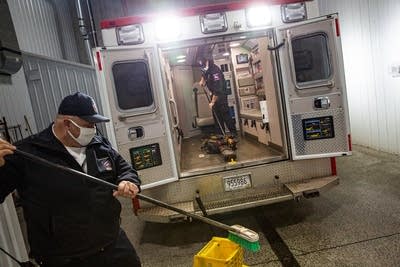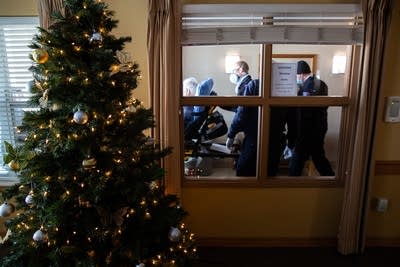Comfort in the chaos: EMS workers adapt and persist, amid stress of pandemic

Paramedic Heidi Rennick describes her first COVID-19 call last spring like “walking on to a movie set.”
When she arrived at the hospital, there were COVID-19-only floors, red tape and full beds.
The challenges have mounted since those first cases, and emergency medical services across the state have adapted with new protocols, treatment plans and personal protective equipment — and in some smaller communities, where emergency medical services are volunteer-operated, shifts have been hard to fill.
Rennick, a staff paramedic, and EMT John Aldrich work together for Lakes Region EMS, covering the Chisago Lakes area, north of the Twin Cities.
Create a More Connected Minnesota
MPR News is your trusted resource for the news you need. With your support, MPR News brings accessible, courageous journalism and authentic conversation to everyone - free of paywalls and barriers. Your gift makes a difference.
They feel those pressures on a daily basis. Even the most routine calls carry higher risk — and require more preparation — than before the pandemic.
Any call could involve a COVID-19 case.
“The other day I had a car accident on I-35, and let me tell ya, to put a gown and a mask and goggles and gloves, trying to get a person out of a vehicle because they might have COVID on top of their injuries, it’s like — ‘Oh my gosh, could it be anything else?’” Rennick said in December.
But it’s important to them to shield the public from the strain they’re feeling.
The challenges aren’t restricted to PPE. The way they work with patients and families has changed. Where a reassuring smile or touch could have comforted a patient or family member in the past, they now have to communicate through face masks and goggles, often from across a room.
And they’re often left telling families that they might not be able to visit their loved one, once they are admitted to a hospital.
“They don’t teach us this, you know. And there’s no book you can read to take a family member out of their home, away from their family, and you just know that they’re not going to make it through this,” Rennick said.
“And I understand that hospitals have their rules and they can only have one family member in dire situations. I get it, but that’s just heartbreaking.”
Throughout the pandemic, the types of calls EMS workers respond to have also changed. Transfers from one hospital or care facility to another have increased significantly. Ambulance crews are responsible for those transfers, caring for patients en route to facilities where they can get a higher level of care.
And back in late fall and early winter, when hospitals neared or reached capacity, they would often transport patients long distances, to get them to an available bed.
Crews from Lakes Region EMS have transported patients as far as Rochester, Minn., Eau Claire, Wis., and even Fargo, N.D., well beyond their coverage area. And that means Rennick, whose job as a paramedic allows her to provide a complex level of care, would be in the back of an ambulance with a patient for hours at a time.
On top of all that, 2020 is projected to have been the deadliest year in U.S. history for drug overdoses. EMS workers are seeing that spike firsthand, as they respond to an increasing number of drug and mental health calls.
And every day is the looming specter of COVID-19. Aldrich tested positive in the fall, and said it took more than a month for him to fully recover.
The calls haven’t slowed, and EMS workers have found ways to power through.
“For me, when I’m not at work is when I seem to struggle with it,” Aldrich said. “When I’m here, you find comfort in that chaos that is EMS and you tighten your boots and get to work.”
COVID-19 in Minnesota
Data in these graphs are based on the Minnesota Department of Health's cumulative totals released at 11 a.m. daily. You can find more detailed statistics on COVID-19 at the Health Department website.
The coronavirus is transmitted through respiratory droplets, coughs and sneezes, similar to the way the flu can spread.





